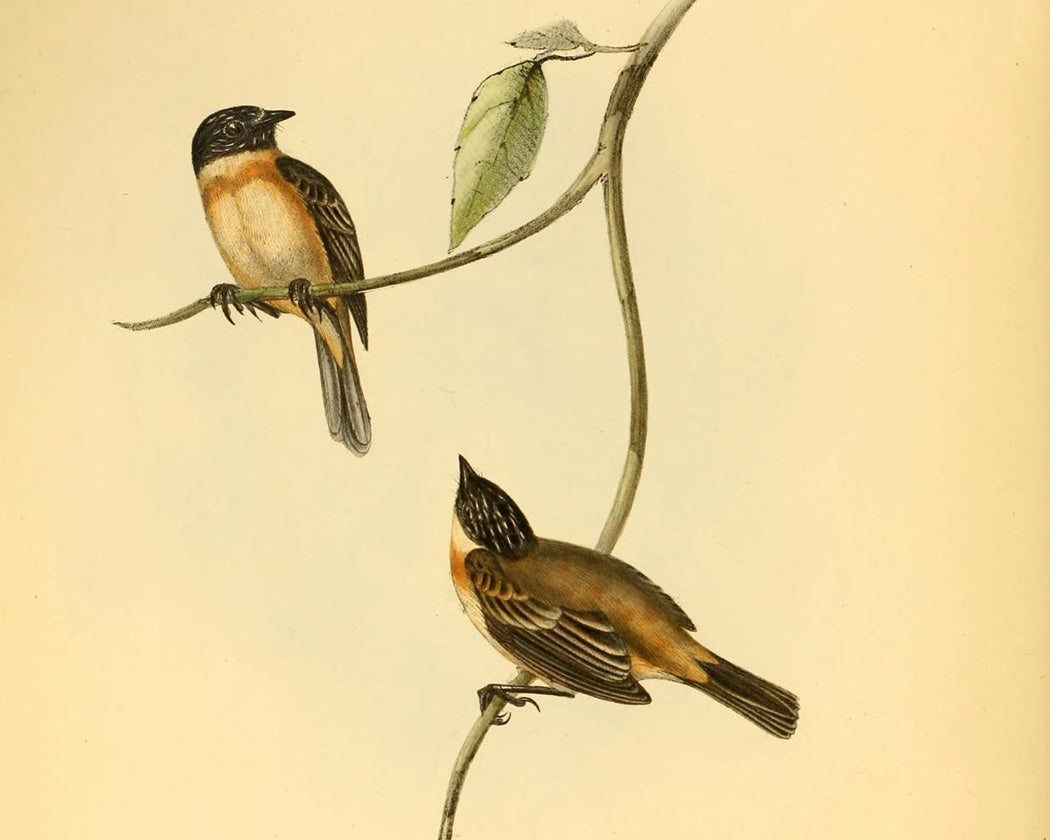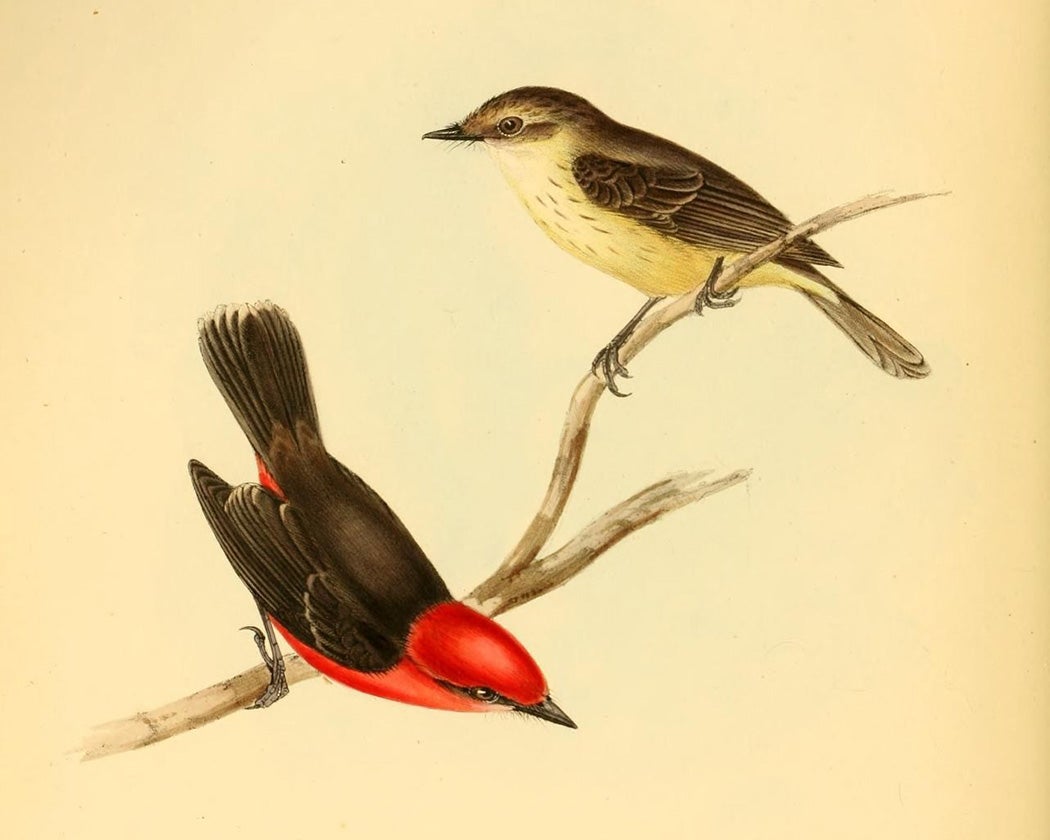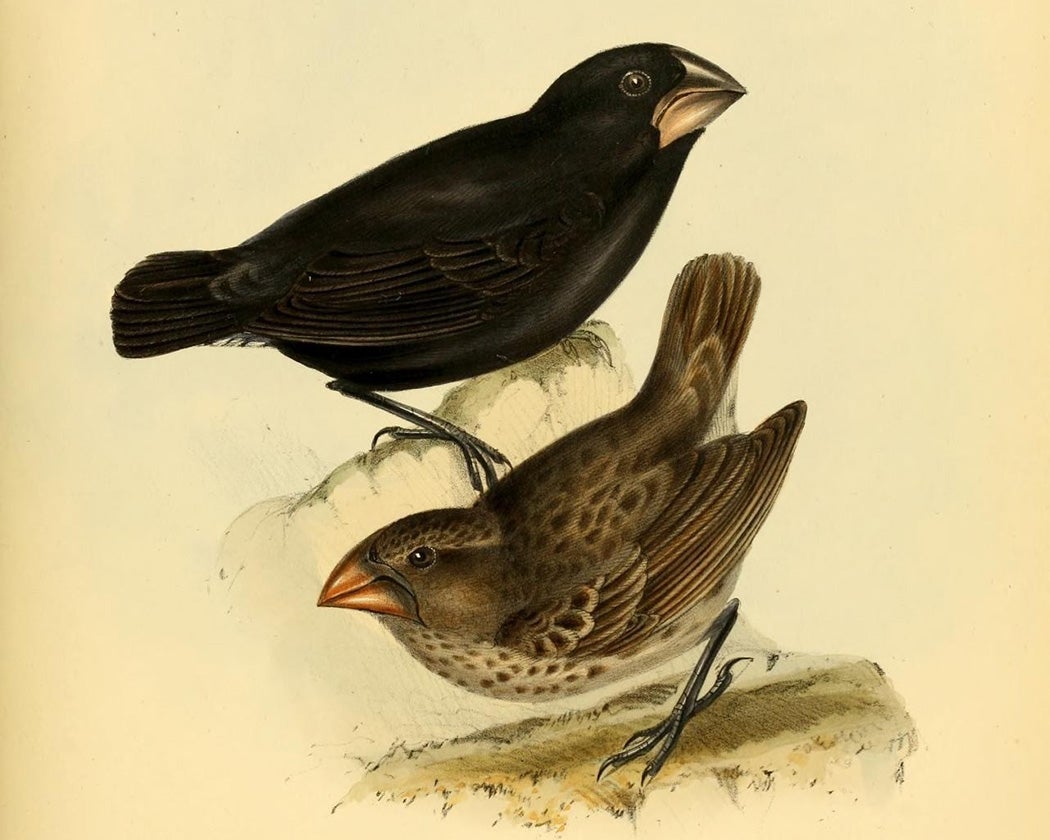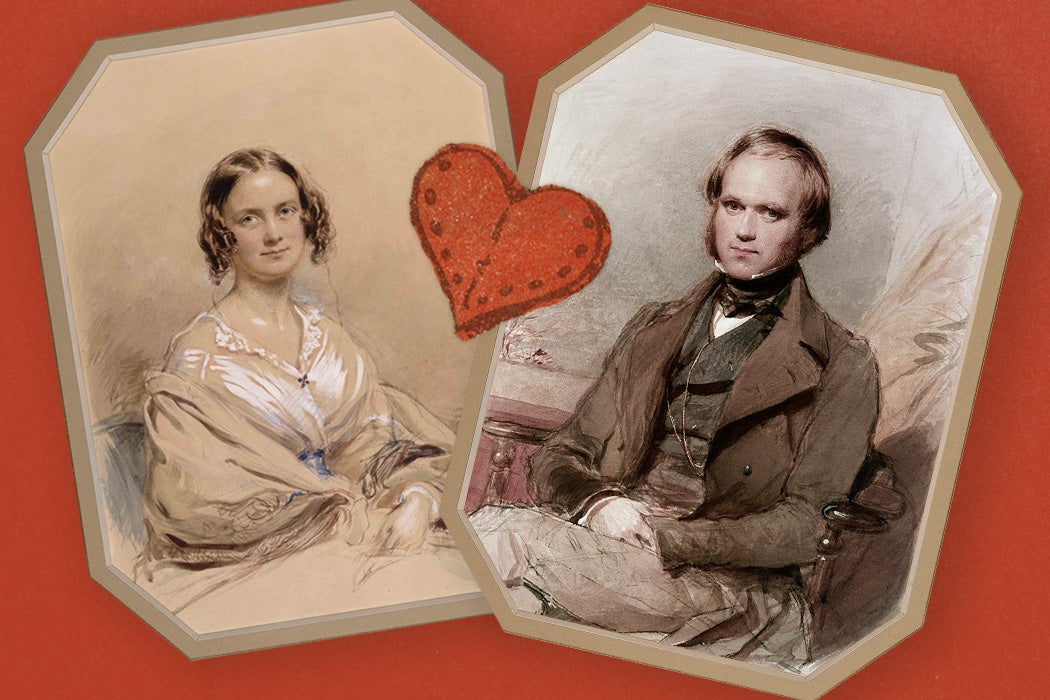On a chilly Tuesday in January of 1839, in a private ceremony at a small Anglican church in rural England, Charles Darwin married Emma Wedgwood. She was the granddaughter of Josiah Wedgwood, the potter who’d made his fortune manufacturing the beautifully painted china, porcelain, and crockery that decorated the homes of wealthy families throughout the world. Though the wedding was a happy one, and the love between Darwin and Emma would prove unshakable, Darwin would eventually realize that they shouldn’t have rushed into marriage. For, in the end, their union may have been the cause of three deaths—and of sorrow that, in turn, may have led Darwin to introduce an interesting category of error in his otherwise stellar scientific descriptions. The problem with the union was that Emma’s grandfather Josiah Wedgwood was Darwin’s grandfather too.
Setting Sail
A little more than seven years before marrying Emma, Darwin had set out on a five-year, around-the-world voyage on the naval ship HMS Beagle. As the ship explored the oceans and coasts of the Southern Hemisphere, it dropped Darwin off at various ports, from which he departed on unprecedented expeditions into uncharted territories. Ranging freely in many exotic locations, Darwin collected thousands of specimens of plant and animal species both long-extinct and still-living.
Weekly Newsletter
Analyzing his specimens and writing books about them was Darwin’s professional occupation during the first twenty years of his marriage. Over that same period, Darwin developed the ideas that would comprise his breakthrough work, the 1859 On the Origin of Species by Means of Natural Selection, or The Preservation of Favoured Races in the Struggle for Life. In that book, Darwin proposed that all of the complex plants and animals of the modern world are the progeny of only a few simple organisms that existed eons ago. The deviation of modern organisms’ morphology from that of their pre-historic progenitors is a result of “natural selection”— the ability of organisms with certain genotypes to survive and thrive under certain environmental conditions, more so than others of their species. As the surviving organisms create progeny, their characteristics help define the species. And so, as the environment changes over the course of millennia, so does life.
Buttressed by the sheer volume of the specimen library that Darwin had collected more than two decades before during his travels, Origin re-aligned Western thought about life on Earth. It also happened to calm a debate several thousand years old about varieties within—and differences among—species. The ancient Greek cosmologist Anaximander had suggested that humans may have evolved from fish. Just fifty years before Darwin published Origin, the French naturalist Jean-Baptiste Lamarck had proposed that microscopic organisms spring spontaneously from inanimate objects and then, powered by an impulse toward perfection, “transmutate” into more complicated forms generation by generation.

Meanwhile, religious leaders and other scientists responded with ideas of their own. Origin was such compelling and convincing reading that it quieted the sometimes acrimonious conversation. Not all reviews were favorable, but, notably, The New York Times called Origin “one of the most important contributions ever made to philosophic science.” Even though the Times’ reviewer remained skeptical about the breadth of Darwin’s claims, he wrote that he was entirely in support of Darwin’s right to argue them.
Charles and Emma in Love
In 1839, a little more than two years after disembarking from the Beagle, Darwin was gob-smacked by love. Emma was an intelligent, level-headed young woman. An excellent pianist, she had studied briefly with Chopin. As Darwin’s feelings for Emma grew, he worried about his looks. In particular, his nose caused him consternation. He knew that the captain of the Beagle hadn’t liked it at all. Indeed, Vice-Admiral Robert FitzRoy was so concerned about what that putty-like blob in the middle of Darwin’s face implied about his health and character, he almost denied Darwin passage on the ship. Yet, at the same time that Darwin was falling for Emma, he didn’t feel at all ready for marriage. This placed him in a pickle. Well-mannered, upper-middle-class British men of Darwin’s day could not presume to court a young woman without proposing.
In one of his many notebooks Darwin unleashed some of his fears about giving up his bachelor freedoms.
If I married tomorrow: there would be an infinity of trouble & expense in getting & furnishing a house, — fighting about no Society — morning calls —awkwardness — loss of time every day. (without one’s wife was an angel, & made one keep industrious). Then how should I manage all my business if I were obliged to go every day walking with my wife. — Eheu!! I never should know French,—or see the Continent—or go to America, or go up in a Balloon, or take [a] solitary trip in Wales — poor slave. — you will be worse than a negro — And then horrid poverty, (without one’s wife was better than an angel & had money) — Never mind my boy — Cheer up — One cannot live this solitary life, with groggy old age, friendless & cold, & childless staring one in ones face, already beginning to wrinkle. — Never mind, trust to chance — keep a sharp look out — There is many a happy slave —
Thinking about Emma, and imagining marriage as slavery, in his spidery handwriting, Darwin scribbled two lists. “Not Marry” included “freedom to go where one liked” and “loss of time,” meaning, he wouldn’t be able to “read in evenings.” “Marry” included “charms of music & female chit-chat” and “better than a dog, anyhow.” The two lists were about equally long, each one running the length of a single page.
Emma was shocked when Darwin proposed. She’d had no idea that they’d been courting, thinking instead that they were friendly relations who enjoyed occasional fireside chats. But she was thirty and still single. And she’d had some hopes about him. She accepted his proposal quickly.

Charles and Emma Darwin had ten children. A baby girl, Mary Eleanor, died twenty-three days after her birth. Ten-year-old Annie died of a respiratory disease that may have been tuberculosis. She’d been sick for several years. She died after having been brought to a medical spa for several weeks of “water treatment,” in which she was heated to the point of perspiration by a lamp burning mentholated spirits, then doused in icy water and rubbed vigorously with cold towels. Eighteen-month-old Charles died of scarlet fever. The rest of the Darwin children lived to adulthood, though their parents worried that several of them seemed particularly fragile.
To be fair to the Darwins, many children at the time died in the weeks after birth, even in families that were not lacking for food and shelter. Antibiotics would not begin to be used as medicine until nearly ninety years after Annie’s death. Raising only seven out of ten children to maturity might have been about average for wealthy British families of their era. (The available statistics are too spotty for a decisive judgment.) Darwin fretted anyway that his decision to marry his first cousin was the cause of his children’s weaknesses. After all, he should have known better. In the years before his marriage, he’d been actively investigating the consequence of inbreeding in animals. And his plant breeding experiments had shown him that even vegetables are more robust when there’s diversity in their parentage.
The Darwins’ marriage lasted forty-three years, until he died. The couple wrote loving letters to each other regularly, even though writing wasn’t necessary. Regardless of how many scientific symposia Darwin was invited to attend, he rarely agreed to spend even a single night away from Emma. Just as Darwin had feared, he and Emma did walk together almost every day.
Darwin’s Later Works
Twelve years after Origin was published, and thirty-two years after the Darwins were married, Darwin’s next major treatise was released. The Descent of Man, and Selection in Relation to Sex applied Darwin’s theory of evolution to the human species, and boldly proposed that humans and modern apes share a common ancestor. It also outlined how the mating preferences of animals within a species could influence natural selection. Cartoonists had a field day with the ideas in Descent, showing, for example, Darwin as a “venerable orangutan” or as a monkey dangling from a tree.
Only a year after Descent, Darwin’s The Expression of the Emotions in Man and Animals was published. Not actually a book of theory, it catalogued a wide range of gestures and behaviors shared by animals and humans. The very presence of nearly identical gestures across species suggested to him that the species’ emotional experiences were similar.
Writing both Descent and Expression in the home where three of his children had died, when describing the mating and family behaviors of animals, Darwin frequently used the word “love.” He may have used the word too easily. For example, he wrote in Descent: “It is certain that associated animals have a feeling of love for each other.” He wrote about mother animals’ love for their young. He also wrote about romance. Referring to birds, in Descent, he mentioned their “love antics,” “ardour in love,” and the “love-dances of the Black-cock.”

Perhaps Darwin didn’t actually mean for his readers to take the term “love” seriously every time that he used it. Perhaps he hesitated to employ more base words like words “sex,” “mating,” or “copulation.” But, in Expression, he also wrote, “Even insects express anger, terror, jealousy, and love,” clearly anthropomorphizing these creatures. He said that that insects achieve this expression by rubbing together certain body parts like wings or hind legs, thereby producing a sound much like a scream. Darwin’s choice of terminology is whimsical at best, especially for a man with his reputation as an observational scientist.
How can we explain this apparent lapse into poetic language? A host of studies have shown that emotions at the time that a memory is recalled can distort the memory. Darwin spent most of his married life very ill, plagued by heart palpitations, visual problems, and prolonged spells of vomiting that may have been due to a parasitic infection acquired from a bug bite in Argentina. For the forty-three years of their marriage, Emma tended to him—and she did so while she tended to three dying children and seven healthy ones. Darwin worked at home. The sights and sounds of misery, anxiety, grief, and even of everyday joy were probably indelibly inscribed on his memory when he sat in his home study and wrote Descent and Expression.
Happily Ever After
Many scientists are more cautious than Darwin was with use of the word “love,” though not all. Biological anthropologist Helen Fisher of The Kinsey Institute points out that deep human emotions like love spring from the brain’s limbic system, which manufactures and releases oxytocin (“the love hormone”) and dopamine, which in large quantities makes humans feel euphoric. She does not consider it too big a stretch to think that, with limbic systems and love-abetting neurotransmitters very much like those of humans, non-human great apes can love, at least in some ways.
Neither does primatologist Jane Goodall consider the ability to feel love out of animals’ reach: “There [is] increasingly compelling evidence that we are not alone in the universe, not the only creatures with minds capable of solving problems, capable of love and hate, joy and sorrow, fear and despair,” she writes. “Certainly, we are not the only animals who experience pain and suffering. In other words, there is no sharp line between the human animal and the rest of the animal kingdom. It is a blurred line.”

Commenting about non-human great apes, Emory University primatologist Frans de Waal writes:
All three species [orangutans, gorillas, and the chimps and bonobos of the pan species] face similar social dilemmas and need to overcome similar contradictions while going after status, mates, and resources. They apply their full brainpower to find solutions. True, our species looks farther ahead and weighs more options than the apes do, but this hardly seems a fundamental difference. Even if we wield the better chess computer, we’re still all playing chess.
So, how big of a mistake was Darwin making in his use of the term “love?” When referring to instinctive, all-consuming mother love, he actually may have been in safe territory, linguistically speaking. An animal doesn’t need higher-order smarts like imagination or the ability to hope to instinctively respond to its progeny’s cry.
When writing about mating, though, Darwin may have over-stated the complexity in the feelings that mammals, birds, and insects have for each other. Mating animals surely know excitement and desire. But do insects hold onto feelings for each other after the mating is over? Do carnivorous female spiders, for example, feel romantic love for their copulation partners as they devour them, post-coitus?
Darwin was buried, with the all of the pomp and circumstance of a state funeral, in a gravesite near Sir Isaac Newton’s, in Westminster Abbey. Being enshrined as one of the timeless stars of British science was a well-deserved honor, for to this day his work profoundly influences all of the biological sciences. If Darwin was occasionally incautious in his choice of terminology, the damage to his reputation is no more than a few light scratches on an otherwise brilliant veneer. And, who knows? His unfortunate use of the word “love” may not be wrong forever. As animal species evolve over the course of the next several million years, they may become capable of deep feelings that we humans, now, cannot even imagine.
Support JSTOR Daily! Join our new membership program on Patreon today.







